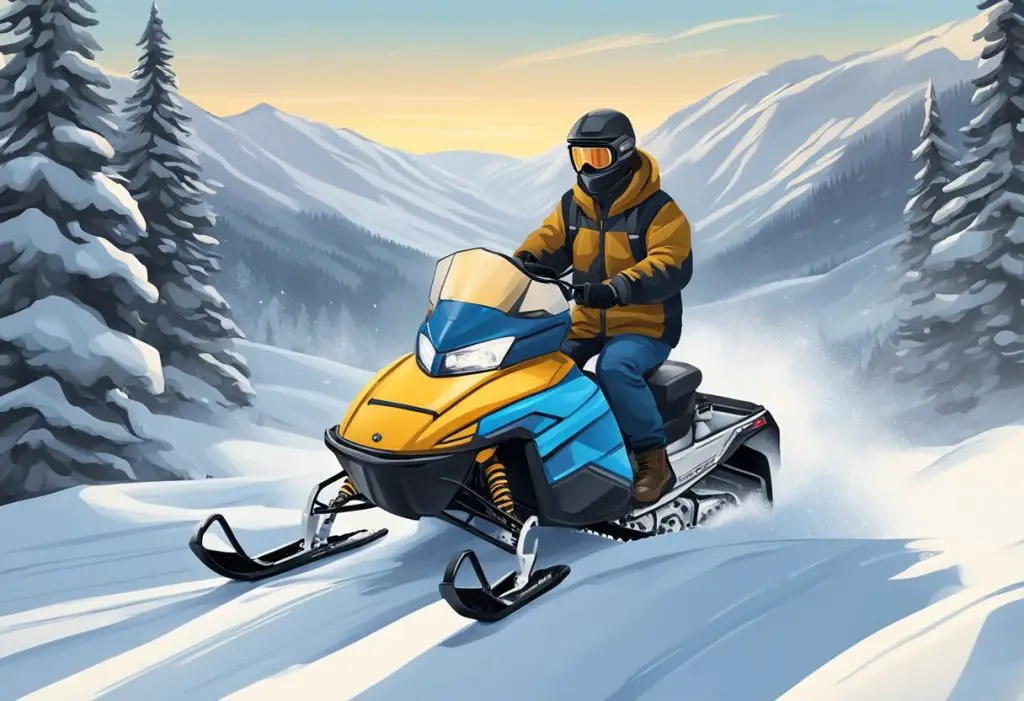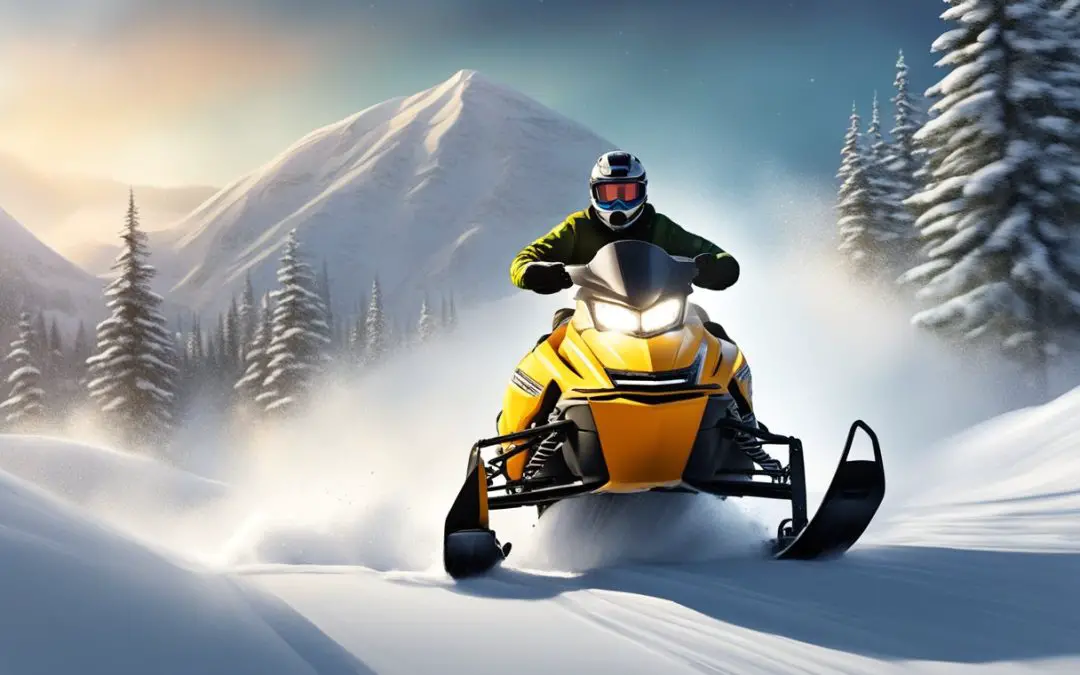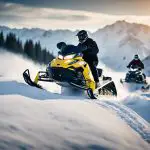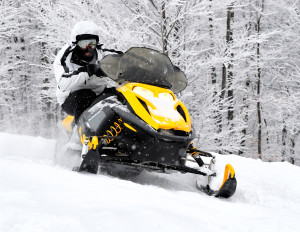Mastering snowmobile operation requires skillful control over starting, stopping, turning, and maintaining the right speed. Below are techniques essential for safe and efficient snowmobile operation.
Snowmobile Operation Techniques
Starting and Stopping
To begin, one engages the throttle gently to start the engine and sets off at a controlled speed. It's crucial to let the engine warm up before hitting the trails. Stopping a snowmobile is not just about hitting the brakes; it involves a gradual decrease in throttle and a steady application of the brake to come to a smooth halt, ensuring the safety of both the rider and the integrity of the machine.
Steering and Turning
Steering requires attentiveness to balance and weight distribution. To steer, the rider turns the handlebars in the desired direction and shifts their weight into the turn for better control. When turning, one should lean into the turn without compromising stability, and use careful throttle control to adjust the speed as needed for smoother maneuvering.
Speed and Momentum Control
Control over speed is regulated by precise throttle control. Gradual acceleration ensures that one maintains momentum without over-speeding. Keeping a consistent speed suitable for the trail conditions allows for better handling. Effective momentum management is key in traversing varying terrains and negotiating turns while maintaining control and stability.
Riding in Different Snow Conditions
Snowmobiling requires riders to adapt to a variety of snow conditions, whether on manicured trails or in the untracked backcountry. Understanding how to navigate these environments is crucial for safety and performance.
Trail Riding
On a trail, conditions can range from hard-packed snow to fresh powder. When riding on trails, it's essential to maintain a steady momentum and use the edges of the skis to carve through turns. It is advisable to stay balanced and react to changes in the terrain promptly, as trails can often be unpredictable. In deep snow, riders should avoid sudden changes in direction to maintain control.
Off-Trail and Backcountry
Off-trail and backcountry riding presents different challenges with unpredictable terrain and the potential for deep, untouched snow. On a powder day, it’s beneficial to leverage wider skis that can float better on the surface. Choosing the right line is vital to navigate around obstacles and ensure you're not stuck in deep snow. Off-trail enthusiasts should have the appropriate gear for any emergencies that occur away from established trails.
Uphill and Downhill Techniques
The uphill techniques involve hitting the slope with enough momentum to reach the top without overworking the engine. Riders must lean forward to distribute weight evenly and prevent the snowmobile from tipping backwards. Conversely, when traveling downhill, it is important to lean back slightly and modulate the throttle to keep a controlled descent. In both scenarios, selecting a manageable path that matches the rider's skill level and the snowmobile's capabilities is critical.
Advanced Snowmobiling Skills
Mastering advanced snowmobiling skills elevates the adventure and fun of riding through diverse terrains. Riders seeking to enhance their experience must focus on technique and precision, especially when cornering at high speeds, navigating through deep snow, and managing jumps and drop-offs.
Cornering and Turning at High Speeds
To corner effectively at high speeds, riders must combine balance and lean. The key is to anticipate the turn early and position the body to the inside of the turn to maintain stability. Shifting weight towards the front helps to keep the skis down and provide better control. It's essential to modulate the throttle to maintain the right speed and using the knees to absorb any bumps or changes in the terrain.
Handling Deep Snow and Powder
Deep snow and powder riding require a unique set of skills, emphasizing the snowmobile's buoyancy and the rider's agility. One must lean back slightly to keep the snowmobile's nose up, ensuring it doesn't get buried in the snow. Throttle control is crucial; the rider must apply a smooth, consistent power to maintain momentum. In deep snow, it's also important to use a rocking motion if the snowmobile starts to sink or gets stuck.
Jumping and Drop-offs
Riders looking to tackle jumps and drop-offs must first ensure they approach with the right speed and balance. When approaching a jump, they should align their weight centrally over the machine to remain in control during the ascent. Upon takeoff, a slight rearward lean helps with balance, and upon landing, bending the knees can help absorb the impact. It is essential to scout the landing area in advance to avoid unexpected terrain challenges.
The basics of riding a snowmobile are just the beginning. Advanced techniques, when practiced with safety and control, contribute massively to the thrill and adventure of snowmobiling. Remember, these machines are heavy. Each skill not only adds to the enjoyment but also to a rider's overall ability to tackle challenging conditions with confidence.

Before venturing into the snowy terrain on a snowmobile, it is crucial to be well-versed in the legal bindings and safety norms. From obtaining the appropriate license to understanding local mandates and preparing for emergencies, these regulations are designed to prevent accidents and ensure the well-being of all riders.
Understanding Local and Federal Regulations
It is imperative that snowmobilers familiarize themselves with both local laws and federal requirements before hitting the trails. You spent a lot of money on your snowmobile, make sure you take this step correct. This may involve procuring a valid license or permit where necessary, and adhering to state-specific regulations that govern where and how snowmobiles can be operated. For example, some regions require snowmobiles to have an unladen weight under a certain threshold, and nearly all will have requirements about the rider's age and the need for safety education certificates.
Riding with a Group: Safety and Etiquette
When partaking in group rides, it is vital for the safety of all participants to follow established etiquette. This includes the use of recognizable hand signals to communicate with one another during the ride. Pre-determined signals can convey intentions like stopping or turning, and can be invaluable for maintaining order and safety within the group.
Group Formation:
- Lead Rider: Sets the pace and makes navigational decisions.
- Sweep Rider: Stays at the back to assist any riders that may fall behind.
Emergency Situations: Avoiding and Handling
The risk of encountering emergencies, such as avalanche danger or a rider getting stuck, compels riders to be prepared. Snowmobilers should undertake avalanche safety courses in prone regions and carry appropriate gear. In the event of a rider getting stuck, knowing the correct techniques for freeing the vehicle without causing injury is essential. It is also advisable to travel with a well-stocked first-aid kit to manage any potential injuries until professional help is available.
- Avalanche Safety:
- Precaution: Check local avalanche forecasts.
- Equipment: Carry transceivers, probes, and shovels.
- When Stuck:
- Self-Rescue: Techniques to dislodge the snowmobile without injury.
- Group Aid: Utilizing the strength of the group to assist.
Snowmobiling for Beginners
When first learning to snowmobile, beginners should focus on mastering the basic riding stance, understanding throttle control, and learning how to ride safely in a group. You don't want to buy a snowmobile and crash it. Each step is crucial to gaining confidence and skill on the snow. And if you are a beginner, avoid trying to get started on a stand up snowmobile.
Basic Riding Stance and Positions
The foundational component of snowmobiling is the riding stance. Beginners should start with their feet shoulder-width apart, knees slightly bent, and body weight evenly distributed. This balanced position offers stability during the ride. Initially, one should practice standing up on the snowmobile, which is useful when traversing uneven terrain. It's essential to use body weight to lean into turns to maintain balance and control.
Control and Throttle Practice
Throttle control is vital for managing the snowmobile's power and speed. Novices must practice applying gentle pressure to the throttle and learn the feeling of acceleration. Start by practicing in a safe, open space until the control feels intuitive. Remember to keep a steady hand and avoid abrupt throttle movements, as this can lead to loss of control.
Learning to Ride with Others
Riding in a group requires understanding and using hand signals for safe communication. Novices should learn the basic signals for stopping, turning, and slowing down. Always keep a safe distance between snowmobiles and match the group's pace without sacrificing control. Practice riding in a group to develop the experience needed for enjoyable and safe group outings.
Special Considerations and Techniques
Mastering the art of snowmobiling requires understanding the environment and respecting the inherent dangers of the sport. This section explores key techniques and considerations for safely navigating extreme conditions, being avalanche-aware, and effectively communicating with other riders.
Riding in Extreme Arctic Conditions
When riding in the Arctic or similar extreme cold environments, selecting the right gear is crucial for maintaining body heat and protection. The rider should equip themselves with specialized arctic clothing that provides insulation while allowing for mobility. They should also be aware of their limits to prevent exhaustion and cold-related injuries. Staying on designated trails and understanding the terrain can mitigate the risks associated with arctic riding.
Avalanche Awareness and Safety
Avalanche safety is paramount when snowmobiling in areas susceptible to snowslides. Riders should have a solid understanding of avalanche risk assessments and carry an avalanche survival kit, including a beacon, probe, and shovel. They should also participate in avalanche safety courses to gain critical knowledge and experience needed for recognizing hazardous conditions. Riding in a group and maintaining a safe distance between snowmobiles can reduce the risk of triggering avalanches.
Communicating with Fellow Riders
Effective communication is necessary for group riding safety, especially in noisy, windy, or limited visibility conditions. Riders should learn and use clear hand signals to convey their intentions and actions to fellow riders. It's also recommended that riders discuss and plan their route, signals, and emergency procedures before setting out. The use of two-way radios can greatly enhance communication, but should not replace the use of signals known to all group members.





